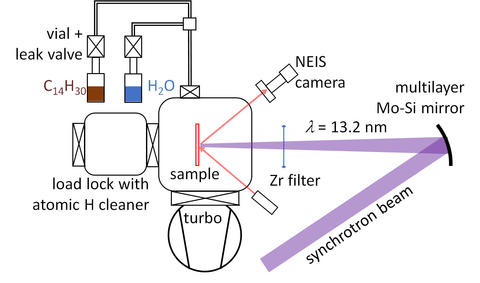Beamline 8: Surface chemistry & durability of EUV optics

Beamline 8 is used to study the degradation of surfaces that are irradiated by EUV radiation in the presence of common outgas species. Its multilayer mirror reflects light at 13.4 nm, the wavelength of interest for EUV lithography. The beamline can be easily modified to study optics degradation at the longer wavelengths relevant to solar-observing satellite instruments.
The beamline uses oil-free pumps to achieve a base pressure well below 10‑6 Pa. To minimize exposure to atmospheric gases, the sample is introduced to the sample chamber through a load lock where an atomic-hydrogen cleaner can be installed to remove organic surface contamination.
A near-normal-incidence multi-layer mirror collects and focuses the synchrotron radiation. A thin-foil Zr filter blocks long wavelengths while transmitting about half of the EUV. This filter also prevents the gases introduced into the sample chamber from reaching the mirror and the synchrotron. The partial pressure of an admitted gas is measured by a quadrupole mass spectrometer which is calibrated against a spinning rotor gauge, yielding an uncertainty better than 5 %.
The contamination rate across the exposure spot can be measured by spectroscopic ellipsometry or x-ray photoelectron spectroscopy (XPS). Comparing this map of carbon thickness to the known distribution of EUV intensity yields the contamination rate as a function of intensity.
Specifications/Capabilities
Base vacuum
- H2 : 1×10-7 Pa
- H2O : 3×10-9 Pa
- N2 : 2×10-9 Pa
- CO2 : 3×10-10 Pa
- organics > 44 amu : < 3×10-11 Pa
EUV on sample
- wavelength : (13.4 ± 0.5) nm
- total power : ~1 mW
- center intensity : ~6 mW / mm2
- distribution : asymmetric gaussian with FWHM = 1.0 mm × 0.6 mm
- spots per sample : 1 to 10
- duration : 1 minute to 1 week
Admitted gases
- one species or a mixture of two species
- partial pressures from 10-9 Pa to 10-3 Pa, measured with 5 % uncertainty
Equipment
- magnetically levitated turbo pump
- load lock with atomic hydrogen cleaner for removing organics from sample
- quadrupole residual gas analyzer (RGA)
- cold-cathode gauge
- spinning rotor gauge
- null-field ellipsometric imaging system (NEIS) for monitoring sample degradation

